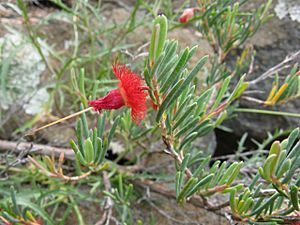Rapier featherflower facts for kids
Quick facts for kids Rapier featherflower |
|
|---|---|
 |
|
| V. mitchelliana in the Australian National Botanic Gardens | |
| Scientific classification | |
| Genus: |
Verticordia
|
| Species: |
mitchelliana
|
Verticordia mitchelliana, also known as the rapier featherflower, is a beautiful flowering plant. It belongs to the myrtle family, called Myrtaceae. This plant grows only in the south-west part of Western Australia, which means it is endemic there.
It's a shrub that stands out with its bright red, rapier-like flowers. These flowers bloom in spring and early summer. They look like tiny swords, which helps tell this plant apart from others. Many people like to grow rapier featherflowers in their gardens. Some garden varieties even have bigger flowers than those found in the wild!
Contents
What Does the Rapier Featherflower Look Like?
The rapier featherflower is a spreading shrub. It usually grows to be about 20–75 cm (8–30 in) tall. It can spread out to be about 0.2–3 m (0.7–10 ft) wide. Sometimes, it can even reach up to 1 m (3 ft) in height.
Leaves of the Plant
Its leaves are long and thin, like lines. If you cut a leaf in half, it would look like a half-circle. Each leaf is about 6–15 mm (0.2–0.6 in) long and has a rounded tip.
Understanding the Flowers
The flowers grow either alone or in small groups. You'll find them near the ends of the branches. Each flower hangs down a bit on a stalk that is about 4–16 mm (0.2–0.6 in) long.
The base of the flower, called the floral cup, is shaped like a top. It spreads out near the top and is about 3 mm (0.12 in) long. It has a small bump under each sepal.
Sepals and Petals
The sepals are bright red and spread outwards. They are about 7–9 mm (0.28–0.35 in) long. Each sepal has 6 or 7 deeply cut, hairy parts, plus two hairy, ear-like appendages.
The petals can be pink, bright red, yellow, or orange. They are about 7–9 mm (0.3–0.4 in) long. They stand upright and are egg-shaped. The outside of the petals has short, soft hairs. The tips of the petals have a few uneven teeth.
The style, which is part of the flower's reproductive system, is about 24–27 mm (0.9–1 in) long and straight. It has a few hairs near its tip. This plant usually flowers from October to December.
How Was the Rapier Featherflower Named?
The rapier featherflower, Verticordia mitchelliana, was first officially described in 1933. This was done by a botanist named Charles Gardner. He found a sample of the plant near a place called Bencubbin. His description was published in a science journal.
The second part of its scientific name, mitchelliana, was chosen to honor Sir James Mitchell. He was the Premier (like a state leader) of Western Australia at that time.
Different Types of Rapier Featherflower
There are two slightly different types, or subspecies, of Verticordia mitchelliana:
- Verticordia mitchelliana C.A.Gardner subsp. mitchelliana has petals that are about 7–8 mm (0.28–0.31 in) long.
- Verticordia mitchelliana subsp. implexior A.S.George & M.D.Barrett has petals that are a bit longer, about 8.5–11 mm (0.3–0.4 in) long.
In 1991, another expert named Alex George studied the group of plants called Verticordia. He placed this species into a specific group called section Intricata. Other plants in this group include V. monadelpha and V. pulchella.
Where Does the Rapier Featherflower Grow?
This plant likes to grow in sandy soil. You often find it alongside other Verticordia plants in areas with heath (low-growing shrubs) and shrubland. It grows in separate areas between Peak Charles and Kulja. These areas are part of the Avon Wheatbelt, Coolgardie, and Mallee regions in Western Australia.
Protecting the Rapier Featherflower
The subspecies mitchelliana is listed as "Priority Three" by the Western Australian Government's Department of Parks and Wildlife. This means that not much is known about it, and it's found in only a few places. However, it's not currently in immediate danger. The subspecies implexior is considered "Not Threatened," which is good news!
Growing Rapier Featherflower in Gardens
People have been growing rapier featherflowers in gardens since the 1970s. Several different types have been developed for gardening. It grows well in various types of soil, as long as the soil drains water easily. This plant is also strong! It can resist pests, and it can handle both dry periods (drought) and cold temperatures (frost). You can grow new plants from both seeds and from cuttings (small pieces of the plant).

